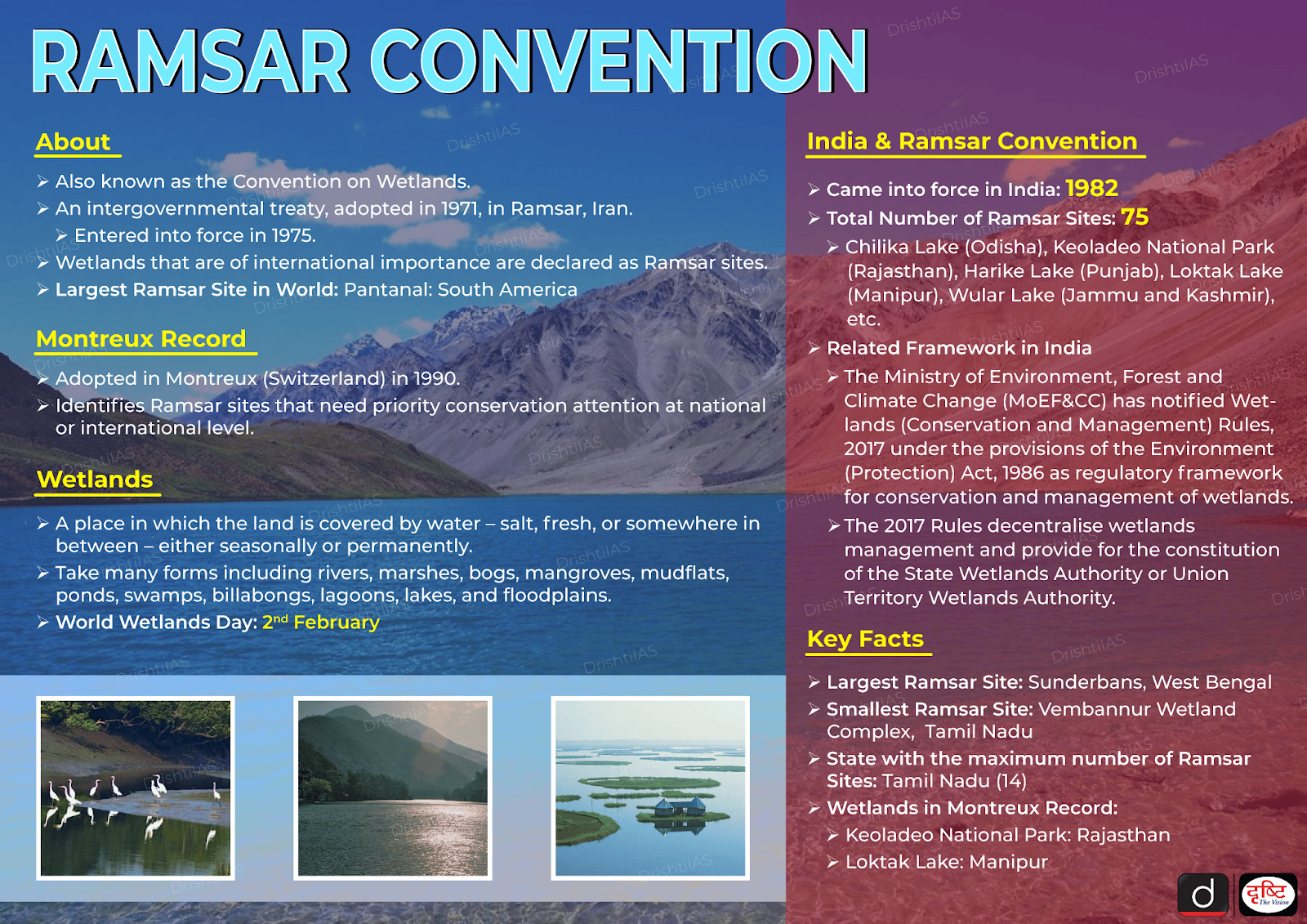Teal Carbon Study at Keoladeo National Park | 11 Sep 2024
Why in News?
Recently, India's first study on 'teal carbon' was undertaken at Keoladeo National Park (KNP) in Rajasthan's Bharatpur district.
- Research has found elevated methane emissions, leading to a recommendation to use specialized biochar to reduce these levels.
- It highlighted the importance of wetland conservation in addressing climate adaptation and resilience challenges. The pilot project aimed to develop nature-based solutions to address climate change.
Note:
- Biochar is a carbon-rich material that enhances soil fertility, water retention, and crop productivity.
- It is made through pyrolysis, which involves heating biomass with little or no oxygen.
What is Teal Carbon?
- About:
- Teal carbon refers to carbon stored in freshwater (non-tidal) wetlands, including vegetation, microbial biomass, and dissolved and particulate organic matter.
- Types of Carbon:
- Teal Carbon is categorised based on its role in ecosystems and its location, distinguishing it from black carbon and brown carbon.
- Unlike black and brown carbon, which are formed from the incomplete combustion of organic matter and contribute to climate change, teal carbon focuses on carbon sequestration within wetland ecosystems.
- Black Carbon: It is a sooty black material emitted from the burning of fossil fuels, comprising a significant portion of particulate matter air pollution.
- Brown Carbon: Produced from the incomplete combustion of organic materials like biomass. It absorbs UV and visible solar radiation, contributing to global warming.
- Blue Carbon: Carbon stored in the atmosphere and oceans.
- Green Carbon: Carbon sequestered in terrestrial plants through the process of photosynthesis.
- Gray Carbon: Emitted from industrial processes and stored in fossil fuels such as coal, oil, and biogas.
- Red Carbon: Released by biological particles found on snow and ice.
- Teal Carbon is categorised based on its role in ecosystems and its location, distinguishing it from black carbon and brown carbon.
- Role in Climate Change:
- Teal carbon ecosystems can play a crucial role in mitigating climate change by sequestering carbon, raising groundwater levels, reducing urban heat islands, controlling greenhouse gasses and mitigating floods.
- Primary Reservoirs:
- The primary reservoirs of teal carbon include peatlands, freshwater swamps, and natural freshwater marshes. These ecosystems are major contributors to the global carbon sequestration total.
- The global storage of teal carbon across ecosystems is estimated at approximately 500.21 petagrams of carbon (PgC).
- Threat:
- They are highly vulnerable to degradation due to pollution, land use changes, water extraction, and landscape modifications which threaten their ability to store carbon and maintain ecological balance.
About Keoladeo National Park
- It is a wetland and bird sanctuary and a UNESCO World Heritage Site located in Bharatpur, Rajasthan.
- Chilika Lake (Orissa) and Keoladeo National Park (Rajasthan) were recognized as the first Ramsar Sites of India in 1981.
- Currently, Keoladeo National Park and Loktak Lake (Manipur) are in the Montreux Record.
- It is known for its rich avian diversity and abundance of waterbirds and is home to over 365 species of birds, including several rare and threatened species, such as the Siberian crane.
- Fauna: Animals such as Jackals, Sambar, Nilgai, wild cats, hyenas, wild boar, porcupine and mongoose can be found in the region.
- Flora: The principal vegetation types are tropical dry deciduous forest dominated by Acacia nilotica intermixed with dry grassland.
- River: Gambhir and Banganga are two rivers that flow through this National Park.
What are Wetlands?
- Wetlands are areas where water covers the soil, or is present either at or near the surface of the soil all year or for varying periods of time during the year, including during the growing season.
- Initiative Taken for Conservation of Wetland:
- Global Level:
- National Level:
- Wetlands (Conservation and Management) Rules, 2017.
- National Plan for Conservation of Aquatic Ecosystems (NPCA)
- Amrit Dharohar Capacity Building Scheme
- National Wetland Conservation Programme (NWCP): It was launched in 1985, to tackle threats to vulnerable wetland ecosystems and enhance their conservation.
UPSC Civil Services Examination, Previous Year Questions (PYQs)
Q. "If rainforests and tropical forests are the lungs of the Earth, then surely wetlands function as its kidneys." Which one of the following functions of wetlands best reflects the above statement? (2022)
(a) The water cycle in wetlands involves surface runoff subsoil percolation and evaporation.
(b) Algae form the nutrient base upon which fish, crustaceans, molluscs, birds, reptiles and mammals thrive.
(c) Wetlands play vital role in maintaining sedimentation balance and soil stabilization.
(d) Aquatic plants absorb heavy metals and excess nutrients.
Ans: (c)
Q. Consider the following statements: (2019)
- Under Ramsar Convention, it is mandatory on the part of the Government of India to protect and conserve all the wetlands in the territory of India.
- The Wetlands (Conservation and Management) Rules, 2010 were framed by the Government of India based on the recommendations of Ramsar Convention.
- The Wetlands (Conservation and Management) Rules, 2010 also encompass the drainage area or catchment regions of the wetlands as determined by the authority.
Which of the statements given above is/are correct?
(a) 1 and 2 only
(b) 2 and 3 only
(c) 3 only
(d) 1, 2 and 3
Ans: (c)
Q. Consider the following pairs: (2014)
| Wetlands | Confluence of Rivers | |
| 1. | Harike Wetlands | Confluence of Beas and Satluj/Sutlej |
| 2. | Keoladeo Ghana | Confluence of Banas National Park and Chambal |
| 3. | Kolleru Lake | Confluence of Musi and Krishna |
Which of the above pairs is/are correctly matched?
(a) 1 only
(b) 2 and 3 only
(c) 1 and 3 only
(d) 1, 2 and 3
Ans: (a)

